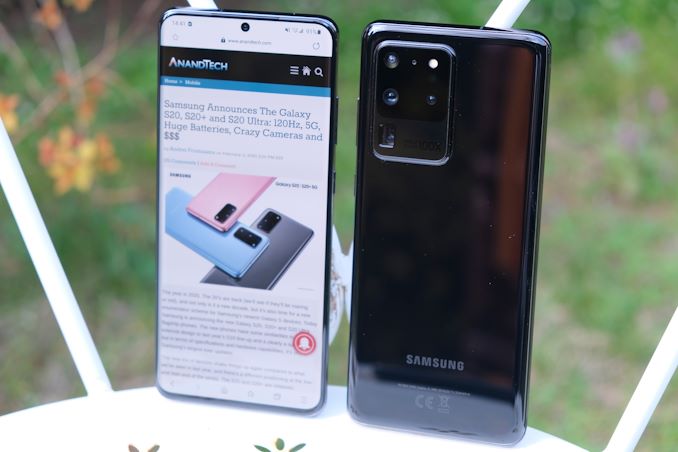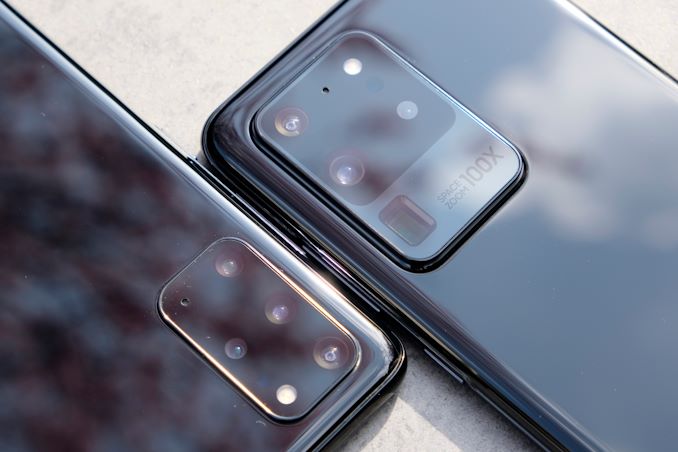The Samsung Galaxy S20+, S20 Ultra Exynos & Snapdragon Review: Megalomania Devices
by Andrei Frumusanu on April 3, 2020 9:30 AM ESTConclusion & End Remarks
We’re coming to an end of what’s a very long review for what probably the most awaited and important Android devices of 2020. Samsung has made several promises as to what the S20 series brings, with the majority of the hype being surrounded around the new cameras, with the other key point being the 120Hz display of the phone.
Starting off with the general design updates of the S20 series, I’m actually extremely happy as to what Samsung was able to achieve with the smaller S20 and S20+ phones, and in part with the S20 Ultra. Samsung’s flattening of the display along with the larger curvatures of the back glass means that, ergonomically, the new phones are a very big improvement over the last few Galaxy flagship generations, allowing the phones to feel smaller than they are – even the humongous Ultra.
The S20 Ultra is in a class of its own when it comes to its size. It’s bigger, thicker, and just feels heftier than anything else Samsung has brought to market in the flagship category. I’m sure there’s plenty people will very much welcome these devices as they’re willing to use bigger and bigger phones, though I’m more prone to stick with the S10+, as I feel the Ultra is just a tad too large.
The other drawback of the Ultra is the camera bump. It’s not that I have anything against camera bumps, it’s just that I feel Samsung could have implemented it with better design elements – particularly the “gasket” – and the gaps around the camera protrusion feels cheap and is very prone to collecting dust. I didn’t have the same reservations about the S20+’s camera design, as that one's perfectly fine and reasonable in my opinion.
The screens of the S20s are all excellent in terms of their quality. The highlight feature of the phones here is simply the 120Hz ultra-high refresh rate. It’s an amazing feature that by itself is able to differentiate the experience of the S20 series, bringing you a much smoother device experience than ever before.
The performance of the S20 series is also excellent. Both the Snapdragon 865 and the Exynos 990 are able to deliver top-notch system performance on the new phones, although the Snapdragon does have a slight edge. Together with the 120Hz refresh rate, these are the snappiest, most responsive devices on the market right now – no contest.
However, the 120Hz refresh does come with quite the battery life cost. Expect a 20-25% reduction in battery life when you use the feature. Here even though the new phones come with extra big batteries, going up to 5000mAh on the S20 Ultra, it’s not sufficient to counteract the high refresh rate power draw. And if you’re coming from a previous generation flagship phone, the net result will be a battery life downgrade. It’s possible that Samsung could improve things with firmware updates and actually introduce a switching refresh rate mechanism to improve the current inefficient system – but we don’t know if and when they’re going to do that.
The power efficiency differences between the Snapdragon and Exynos are acceptable in everyday usage, however if you’re a power user, particularly in gaming, the Exynos 990 won’t fare very well. The M5 CPU is a disappointment and isn’t competitive with the Cortex-A77 cores of the Snapdragon. But at least it’s the last generation of Exynos SoC having to live with such a disadvantage. The GPU performance of the SoC is also very disappointing, as the long-term performance will only be around half of the Snapdragon models.
Then there’s the cameras. Samsung put such an emphasis on the camera capabilities of these phones that frankly we expected the most amazing results ever. In my mind in particular I had expected for Samsung to compete with Huawei in terms of picture quality, both in daylight and in low-light.
In daylight, the one strength of the phones that does materialize is the S20 Ultra’s telephoto module. The sheer hardware prowess of this camera is leaps ahead of other devices in the market right now. Sure, Samsung went a bit too far with proclaiming it’s able to achieve up to 100x zoom – those pictures are just a blurry mess. But it does fare very well at 10-20x magnification, and provides some shots that you normally wouldn’t think possible out of a phone.
The main camera sensors on the other hand I feel fall short of the high expectations. Yes, they are better than what we see on the S10 series, however Samsung here is still falling short of proving the same quality that Apple achieves on the iPhone 11 – and it’s also optically inferior to Huawei’s newest devices. I just don’t quite see why the 108MP sensor on the S20 Ultra had to be an 108MP sensor, as I don’t feel that number of pixels translates in anything meaningful in any of the camera usages of the S20 Ultra. In fact, more often than not, the S20+’s 64MP camera unit is able to take more detailed pictures.
The S20+’s 12+64MP combination is I think more versatile than that of the S20 Ultra, and the area where this shows the most is in the 1.2-3.5x zoom range, where the Ultra just falls apart, but the S20+ still is able to take perfectly detailed pictures. The ultra-wide-angle’s reduced resolution from 16MP to 12MP is a straight downgrade for daylight pictures, it does however make this up with better low-light pictures.
Then there’s low-light, which is just a massive mixed bag of results. Here it’s clearly a matter of the software not being optimized, as sometimes all the S20 perform worse than the S10 phones. Yes, in the perfect conditions the phones are able to shine – particularly the Exynos models, which currently have much better low-light camera calibrations and processing – but even in that best-case scenario Samsung is far behind the results that Huawei is able to achieve.
Megalomania Devices - But Still Good Phones
I've taken to calling the S20 series megalomania devices because, $1400 price tags and all, they’re overpromising and underdelivering – however that doesn’t mean they’re bad phones. Other than the display size and the excellent zoom module, I don’t really see the value in the S20 Ultra over the S20+. The 108MP camera in particular feels underutilized. Given the steep price premium over the S20+, I’m having a hard time rationalizing this phone over its smaller siblings.
The S20+ I feel is a proper successor to the S10+, and I’m even willing to switch over to it as a daily device. The 120Hz screen remains incredible no matter the battery life impact, and the cameras are still plenty good, even if not class-leading. The users in Snapdragon markets in particular end up with a device that makes very few compromises and is seemingly worthy of being a top class 2020 flagship. I just hope that Samsung will be able to resolve the camera discrepancies between the different models, as well as generally improve the camera picture quality over the coming months. If they achieve this, then I feel that the new phones would warrant their release price tags.












137 Comments
View All Comments
StrangerGuy - Wednesday, April 8, 2020 - link
$1400? Geez, I thought $1100 for the Ultra here in Singapore was already stupid overpriced especially when all S20 variants here are only available in 128GB and the Note 10+ 256GB is just $590.Cliff34 - Friday, April 3, 2020 - link
When I upgraded from s3 to s7, I was so impress by the new phone. Long battery life, great camera and fast cpu.Now I upgraded to s20+ and instead of feeling the aww feeling, I'm more like meh.
It comes w great features but they are all come w a cost. Great camera but if you take 64meg photos, it takes a few seconds to process. Great screen but if you switch on 120 hertz, your battery drains fast.
Hindsight, s20 is good enough for me.
philehidiot - Friday, April 3, 2020 - link
This is why I simply won't buy a new phone until I've waited for the Anandtech review. It takes a long time to come out and even longer to read but it has saved me a few bad decisions and premature upgrades. As well as a tonne of cash. I'm still on my S8 and the missus is on the S7 and y'know what? They're just fine. My only issue with the S8 is a recent update which is resulting in markedly increased screen brightness when set to auto. Try and drag the brightness back down and it just goes back up again. I can only imagine that "feature" was added to convince people it's time to upgrade. The only other issue is a bit of lag here and there but it's not a massive issue. I'm in the UK, so I absolutely will NOT pay Samsung for a product that is so inferior to other markets but they market and expect me to value exactly the same. I'm no problem with different internals for different markets and I've no problem with parts being sourced from different suppliers. BUT, you either change the price to reflect the value or you keep the specs of the different parts near enough the same if you want the value to be the same.Now, if you'll excuse me, for some strange reason my middle finger has gone stone cold and needs a rest. As if the blood has drained from it as a result of spending so much time erected in Samsung's direction.
phoenix_rizzen - Friday, April 3, 2020 - link
Install Lux and let that manage the auto-brightness. On the S6, S7, and A8 (2018), Lux does a much better job managing brightness than Samsung's settings. And you can set your own targets for "at this level of ambient light, set the brightness to this level", which is especially handy for lower light levels.On the S10e, I haven't bothered to install Lux, as Samsung's Adaptive Brightness eventually catches up to my preferences and is working well enough.
philehidiot - Friday, April 3, 2020 - link
Ahh sweet, cheers! I'll have a look at that now. The adaptive brightness has worked fine for several years and only since an update has it gone very strange.shabby - Friday, April 3, 2020 - link
Can all the cameras on the s20+ record in 4k60fps? In the s10 only the main one could so you couldn't record in 4k60 while switching between the sensors.Andrei Frumusanu - Friday, April 3, 2020 - link
It's unfortunately still only limited to the main camera module.shabby - Friday, April 3, 2020 - link
Damnitiamlilysdad - Friday, April 3, 2020 - link
While waiting for display accuracy comparison charts, can you post "old style" dE results so we can do our own comparisons? Or, even better, provide a timeline and list of devices that you're going to go back and retest using the new methodology/rating system?FunBunny2 - Friday, April 3, 2020 - link
I'm not a phone junkie, doh!, but isn't refresh rate tied to content/application coding? IOW, only content/applications written to display at 120 will benefit? Otherwise, won't the screen just refresh twice on the 60hz line?